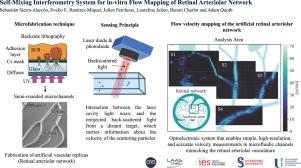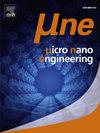视网膜小动脉网络体外血流定位的自混合干涉测量系统
IF 3.1
Q2 ENGINEERING, ELECTRICAL & ELECTRONIC
引用次数: 0
摘要
自混合干涉测量(SMI)是一种光学传感技术,可以创建紧凑的,一体化的光学传感器,用于高分辨率测量,使其成为流量测量应用的有吸引力的工具,例如微流体系统中的速度测绘。该领域的大多数研究都集中在人造矩形或圆形通道上,这些通道不能完全复制到活体结构中。本研究展示了SMI在模拟视网膜小动脉网络的微通道中速度映射的应用。这些微通道是用背面光刻技术制造的,这是一种新的技术,可以产生与体内条件非常相似的半圆形几何形状。开发了高分辨率SMI系统,实现了精确的速度测量,空间分辨率为1 μm,可以获得详细的流动剖面,并且可以在较低分辨率下更快地扫描全局流动模式。该系统能够重建速度图,并在人工血管网络中跟踪流量变化,这突出了SMI传感器在更复杂的活体应用中的潜力。本文章由计算机程序翻译,如有差异,请以英文原文为准。

Self-mixing interferometry system for in-vitro flow mapping of retinal arteriolar network
Self-Mixing Interferometry (SMI) is an optical sensing technique that enables the creation of compact, all-in-one optical sensors for high-resolution measurements, making it an attractive tool for flowmetry applications, such as velocity mapping in microfluidic systems. Most research in this area has focused on artificial rectangular or circular channels, which do not fully replicate in vivo-like structures. This study demonstrates the application of SMI for velocity mapping in microchannels designed to mimic the retinal arteriolar network. These microchannels were fabricated using backside lithography, a novel technique that produces semi-rounded geometries closely resembling in vivo conditions. A high-resolution SMI system was developed, achieving accurate velocity measurements with a spatial resolution of 1 m for detailed flow profiles, as well as faster scans at lower resolutions for global flow patterns. The system’s ability to reconstruct velocity maps and track flow variations within an artificial vascular network highlights the potential of SMI sensors for use in more complex, in vivo-like applications.
求助全文
通过发布文献求助,成功后即可免费获取论文全文。
去求助
来源期刊

Micro and Nano Engineering
Engineering-Electrical and Electronic Engineering
CiteScore
3.30
自引率
0.00%
发文量
67
审稿时长
80 days
 求助内容:
求助内容: 应助结果提醒方式:
应助结果提醒方式:


